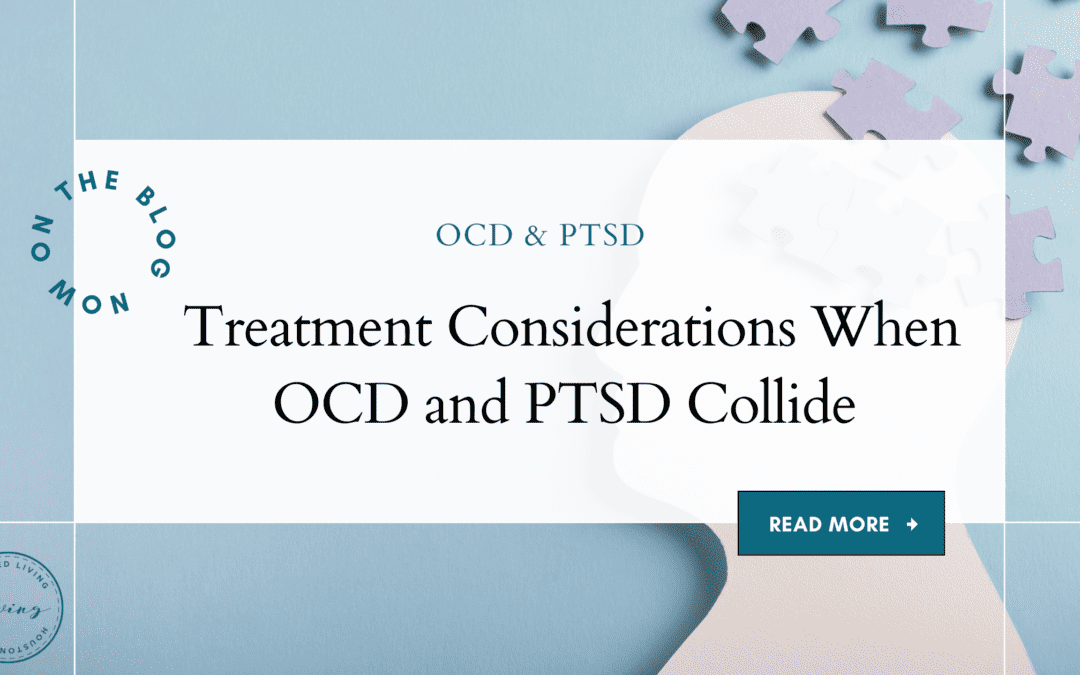Obsessive Compulsive Disorder impacts about 1.2% of the population in the US annually. 3.5% of the US population is affected by PTSD every year. Many people living with OCD have experienced trauma in their lives and research has shown that OCD is much more prevalent in people who also have Post Traumatic Stress Disorder. In fact, OCD risk increases with each traumatic event and of people with severe OCD, 44% believe that their OCD was caused by a stressful or traumatic event.
With OCD, trauma can impact the onset and severity of symptoms, the theme of OCD, and the core fear. There are some differences in symptoms between OCD that started before a traumatic event versus OCD that started after trauma. Many similarities exist in symptoms between OCD and PTSD, which can make differentiating the two sometimes difficult. Accurate diagnosis is crucial however, because it is important to treat both disorders with the appropriate therapy approaches for best treatment results.
Post Traumatic Stress Disorder (PTSD) is a mental health condition that is triggered by a traumatic event. According to the Diagnostic and Statistical Manual for Mental Disorders-5th Edition (DSM-5), a trauma is defined as exposure to actual or threatened death, serious injury, or sexual violence either by directly experiencing the event or witnessing the event as it occurred to others. According to DSM-5, learning that a traumatic event occurred to a close family member or a friend or experiencing repeated or extreme exposure to aversive details of the traumatic event (such as might be the case with police officers or first responders) are considered traumatic as well. However, people are impacted by many different situations that may not fit the narrow definition of trauma in the DSM-5 and experience symptoms that are similar to the PTSD diagnosis in the DSM-5. If your experience does not fit the definition above but you are feeling the effects of trauma, know that your experience is valid and important.
Symptoms of PTSD are grouped into four types in the DSM-5: intrusive memories, avoidance, negative changes in thinking and mood, and changes in physical and emotional reactions. An example of intrusive memories might be flashbacks of the traumatic event or recurring nightmares. People often start to avoid the places, people, and situations that remind them of the traumatic event. Is it also common to go to great lengths to try to avoid the thoughts and memories related to the trauma. Negative changes in thinking and mood include feeling hopeless about the future, feeling detached from loved ones, and feeling numb, among others. Lastly, individuals might be easily startled or frightened, engage in self-destructive behaviors, and have trouble sleeping or concentrating. PTSD symptoms might vary over time but if these symptoms get more severe and last more than a month, a PTSD diagnosis is likely warranted.

OCD and PTSD are similar in that they both involve intrusive, unwanted thoughts and images that lead to compulsive behaviors aimed at gaining certainty or alleviating uncomfortable sensations. Both also involve significant avoidance of triggering situations. OCD and PTSD both involve safety behaviors, which are any observable or internal actions that are used to try to avoid, suppress, reduce, or prevent uncomfortable sensations, such as anxiety. Safety behaviors might alleviate discomfort momentarily but actually strengthen symptoms in the long term. A hallmark similarity between OCD and PTSD is uncertainty intolerance, which means difficulty handling situations where certainty cannot be obtained. Many other behaviors, such as reassurance seeking, checking, and ruminating, can indicate either OCD or PTSD. For therapists, it is important to discuss the origin of these behaviors in order to fully understand the unique needs and symptoms of each individual.
Thankfully many evidence-based treatments for both OCD and PTSD exist. Research has shown that Exposure and Response Prevention, Acceptance and Commitment Therapy, and Inference-based Cognitive Behavioral Therapy are all effective in treating OCD. For PTSD, the recommended treatments are Prolonged Exposure, Cognitive Processing Therapy, Trauma-focused Cognitive Behavioral Therapy, and Eye Movement Desensitization and Reprocessing. While there are currently no treatment modalities that target OCD and PTSD at the same time, many of these therapy approaches can easily be combined.
When meeting with a therapist, be open and honest about your current symptoms. Together with your therapist you can decide if OCD and PTSD should be targeted separately or at the same time. Having PTSD does not mean that your OCD should not be treated as well, and vice versa. You might prefer to have two separate treatment providers, but it is not mandatory. Many clinicians are trained to treat both conditions and a combined approach is likely to give you the quickest benefit, especially if your OCD and PTSD symptoms are related.
If you have questions about how to treat OCD and PTSD simultaneously or if you are looking for a treatment provider, please contact us. Help is available and you are not alone.

At the Houston Center for Valued Living, we offer therapy in Houston for a variety of life’s challenges. Our team of compassionate therapists offer a variety of therapeutic specialties including:
- OCD
- Intensive Treatment for OCD
- Anxiety
- Insomnia
- Depression
- Reproductive Mental Health
- Children
- Parenting
- Adolescents & Teens
- Trauma/PTSD
- Body focused repetitive behaviors

